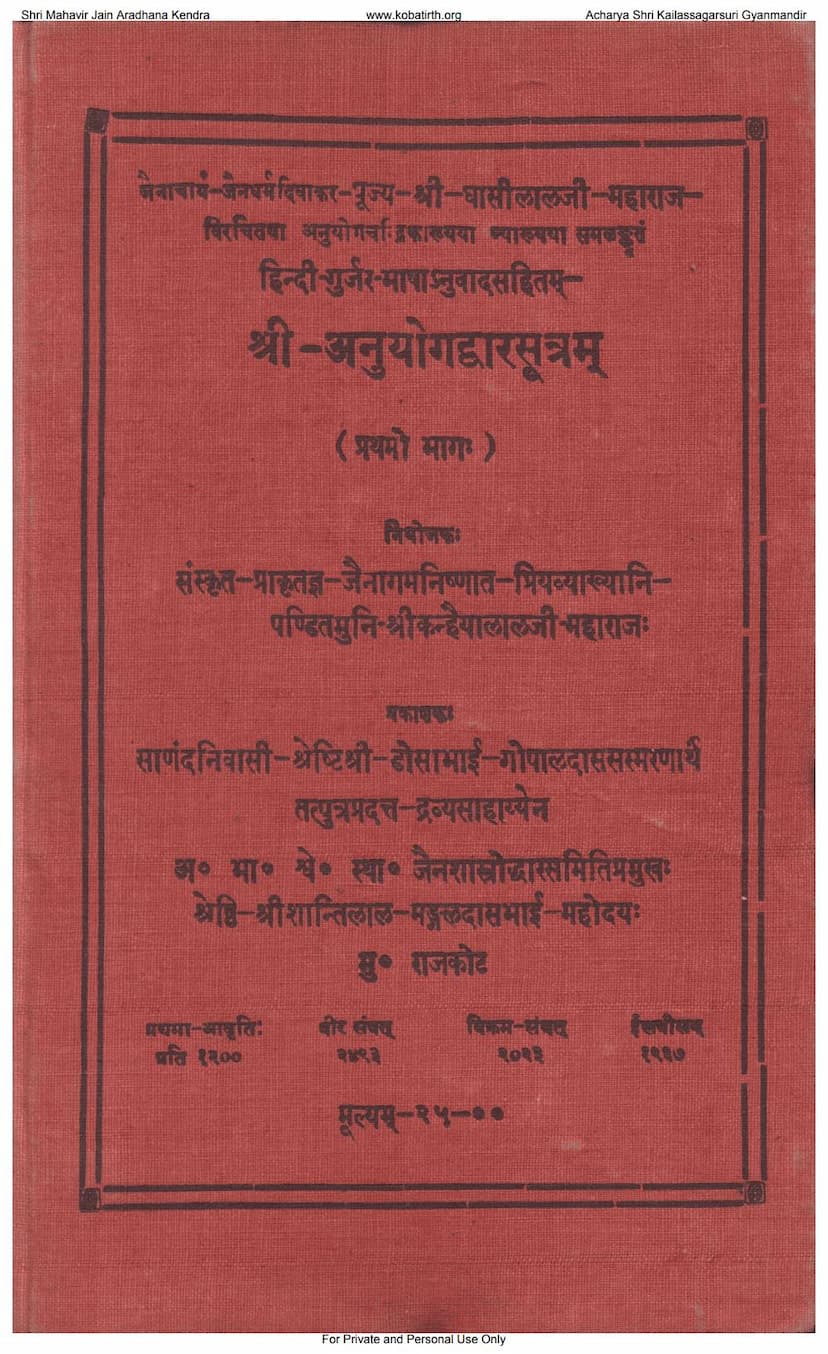Anuyogdwar Sutram Part 01
Added to library: September 1, 2025

Summary
Here is a comprehensive summary of the provided Jain text, "Anuyogdwar Sutram Part 01," based on the given pages:
Book Title: Anuyogdwar Sutram Part 01 Author: Kanhaiyalal Maharaj Publisher: A B Shwetambar Sthanakwasi Jain Shastroddhar Samiti
Overall Purpose and Structure:
The "Anuyogdwar Sutram" is a foundational text in Jain Agamas, focusing on clarifying and classifying various aspects of Jain doctrine and philosophy. This volume, specifically Part 01, serves as an introduction and detailed exploration of key concepts within the Anuyogdwar. It aims to provide a systematic understanding of knowledge, essential duties (Aavashyak), and other important principles, presented with commentaries and translations in Hindi and Gujarati for wider accessibility. The text meticulously breaks down complex concepts into manageable parts, often using logical frameworks and comparative analysis.
Key Themes and Concepts Discussed (Based on the provided Table of Contents and selected pages):
The table of contents (pages 4-9) reveals a vast and intricate structure of topics covered in this volume. The overarching goal is to explain the "Anuyog" (exposition, discourse) of the "Dwar" (gates, approaches) to understanding the scriptures. The text is divided into numerous sections, each delving into specific philosophical or practical elements of Jainism.
Here's a breakdown of major thematic areas and specific concepts:
-
Types of Knowledge (Gyan):
- The text begins by defining the five types of knowledge in Jainism: Abhinibodhic Gyan (sensory or empirical knowledge), Shrut Gyan (scriptural knowledge derived from listening or reading), Avadhi Gyan (clairvoyant knowledge), Manahparyay Gyan (telepathic knowledge), and Keval Gyan (omniscient knowledge).
- Significant emphasis is placed on distinguishing these types, explaining their scope, limitations, and the causes of their attainment (karma degradation).
-
Essential Duties (Aavashyak):
- A major portion of the text is dedicated to the detailed exposition of the six essential duties (Aavashyak) for a Jain monk and layperson. These are considered fundamental practices for spiritual progress.
- The text explores the nature (Swaroop) of each Aavashyak.
- It deeply analyzes the Niksēp (Nixēp) of Aavashyak, which is a complex analytical framework in Jainism. Niksēp involves categorizing phenomena through different perspectives:
- Nam (Naam): The conceptual name or label.
- Sthapana (Sthapana): The symbolic representation or idol.
- Dravya (Dravya): The substantial or material aspect.
- Bhava (Bhava): The essential or spiritual aspect.
- The text likely differentiates between Naam Aavashyak, Sthapana Aavashyak, Dravya Aavashyak, and Bhava Aavashyak, explaining how these concepts apply to the six essential duties.
- The classification and sub-classification of Aavashyak, including concepts like Sanchita Aavashyak (accumulated), Nirankart Aavashyak (without agent), and Chakravarti Aavashyak (wheel-turning, possibly referring to cyclical duties), are explored.
-
Scriptural Exposition and Methodology (Anuyog):
- The core concept of Anuyog (exposition or discourse) and its "gates" or Dwar (approaches) are central. The text explains that understanding scriptures requires following specific methods.
- The four primary Dwar (gates) of scriptural exposition are discussed:
- Upakram (Upakram): Introduction and preliminary remarks, setting the stage for the discourse.
- Niksēp (Niksēp): The analytical framework mentioned above for understanding concepts.
- Anugam (Anugam): Logical progression and connection of ideas.
- Nay (Nay): The philosophical standpoints or perspectives used to analyze reality.
- The text emphasizes that the Anuyog must be consistent with the teachings of the Tirthankaras, as preserved by the Ganadharas (disciples of Tirthankaras).
-
Categories of Things (Padarth):
- The text systematically categorizes various aspects of reality according to Jain ontology and epistemology. This includes the treatment of different types of substances (Dravya), their qualities (Guna), and their modifications (Paryay).
- Sections on Skandha (Skandha) (aggregate or cluster of atoms) and their sub-types (Sanchit, Achit, Mishra) are mentioned, indicating an exploration of the nature of matter (Pudgala).
-
Naya (Naya) – Philosophical Viewpoints:
- The text likely delves into the seven Nayas (viewpoints) in Jain philosophy, which are crucial for reconciling apparent contradictions and understanding reality from multiple perspectives. These Nayas include Naigama, Sangraha, Vyavahara, Rjusūtra, Shabda, Samabhirūḍha, and Evambhūta. The discussion on Dravya Aavashyak and its various categories often involves an analysis through these Nayas.
-
Theological and Ascetic Practices:
- Concepts like Virati (abstinence), Gupti (three types of control), and Samiti (five types of carefulness) are discussed in relation to the conduct of ascetics.
- The text also touches upon the importance of Samyak Darshan (right faith) and Samyak Gyan (right knowledge) as the foundation for spiritual progress.
-
Biographical and Dedicatory Information:
- The initial pages include dedications and tributes to prominent individuals, such as Seth Shri Dosa Bhai Gopal Das, whose memory is honored through the publication of this text. This highlights the community's role in preserving and propagating Jain scriptures.
- The biography of Seth Dosa Bhai reveals his devout Jainism, compassion towards animals, and active participation in religious activities, serving as an example of Jain practice.
Commentary (Anuyog Chandrika) and Translations:
The book is enriched by the "Anuyog Chandrika" commentary, authored by Pujya Shri Ghasilalji Maharaj. This commentary aims to elucidate the intricate meanings of the Anuyogdwar Sutra. The inclusion of Hindi and Gujarati translations makes the profound concepts accessible to a wider audience, transcending linguistic barriers within the Jain community.
Overall Significance:
"Anuyogdwar Sutram Part 01" is a significant work for anyone seeking a deep and systematic understanding of Jain philosophy, particularly the foundational principles of knowledge, duty, and scriptural interpretation. The detailed breakdown of concepts, combined with the insightful commentary and translations, makes it an invaluable resource for Jain scholars, practitioners, and students. The text reflects the rigorous analytical approach characteristic of Jain Agamic literature, seeking to illuminate the path to spiritual liberation through precise understanding and practice.